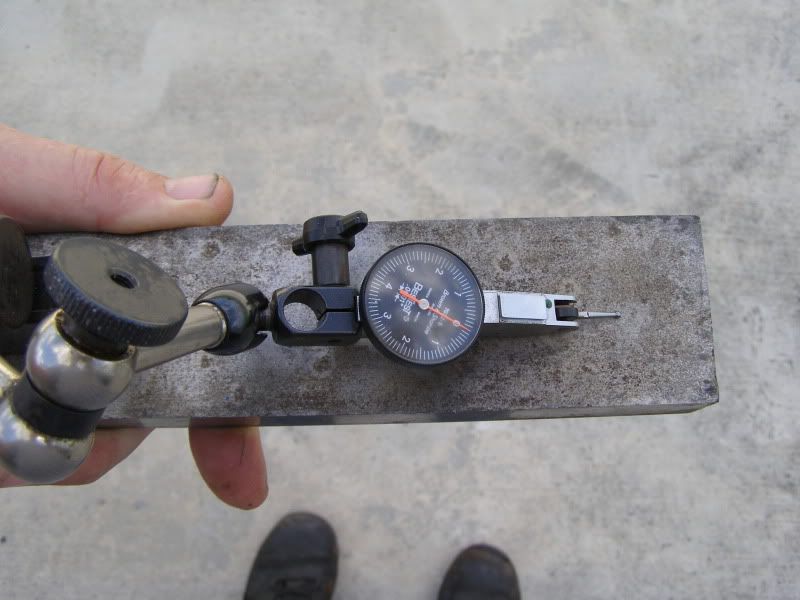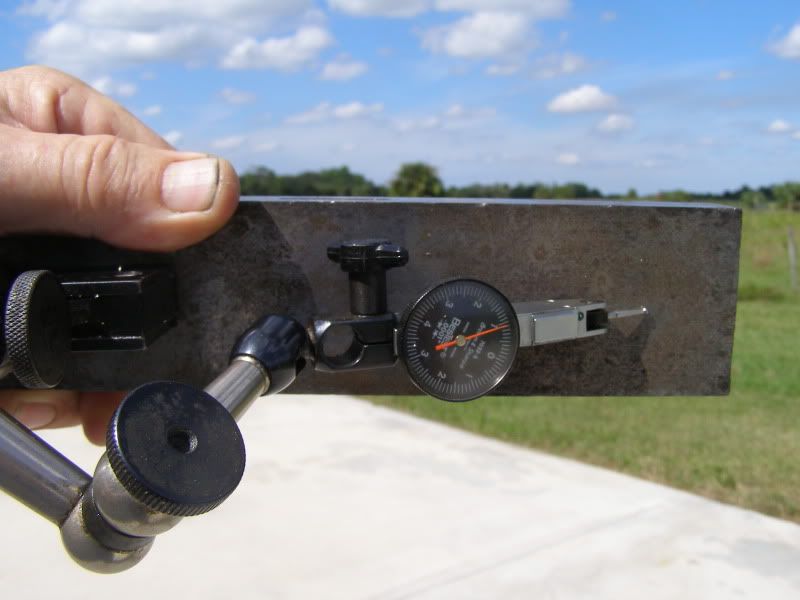HELP: improving lathe carriage accuracy??
I mounted a dial indicator in my chuck, and checked the alignment of the TS. As predicted, the centre was off by .005 (L-R). I adjusted it, and now it's centered (LR)
I made a troubling discovery during this task.
The TS centre is slightly higher than it should be (roughly .005)
How big of a problem is this?
I made a troubling discovery during this task.
The TS centre is slightly higher than it should be (roughly .005)
How big of a problem is this?
-
Russ Hanscom
- Posts: 1955
- Joined: Wed Mar 15, 2006 11:10 pm
- Location: Farmington, NM
Here is an easy way to monitor tailstock offset and to see how much it moves when you want to move it. In this case, the indicator mount is screwed to the tail stock base and the indicator tip is touching a piece screwed to the upper part of the tailstock. A thumbscrew holds the indicator in the mount.
I can't do the math off the top of my head, but it's a lot less than if the TS is 5 thou forward or back.Hank.W.E wrote:The TS centre is slightly higher than it should be (roughly .005)
Think about having an indicator on the side of a round workpeice and then moving it up 5 thou. It will move only slightly in.
Many lathe manufacturers make it a little high to account for wear, although 5 thou seems like quite a bit. Maybe there are shims in there you could remove?
What was the result in turning after adjusting the tailstock?
Russ - neat tool. Maybe I should make one of those for one of the spare indicators I have lying around.
Steve
-
Russ Hanscom
- Posts: 1955
- Joined: Wed Mar 15, 2006 11:10 pm
- Location: Farmington, NM
Hank,
The error from vertical offset gets worse with smaller diameters and when the tool is above or below the centerline. It is my understanding that new lathes usually come with the tailstock set .0005 high to allow for wear; .005 seems like too much.
You might remove the tailstock from the lathe and separate the upper and lower sections. Check for debris and dings. If it is still too high after you reassemble it, might consider having one of the pieces ground down with a surface grinder until you get to the desired slightly high dimension.
The error from vertical offset gets worse with smaller diameters and when the tool is above or below the centerline. It is my understanding that new lathes usually come with the tailstock set .0005 high to allow for wear; .005 seems like too much.
You might remove the tailstock from the lathe and separate the upper and lower sections. Check for debris and dings. If it is still too high after you reassemble it, might consider having one of the pieces ground down with a surface grinder until you get to the desired slightly high dimension.
Re-post from another thread:
DTI's on arms and sag error when used horizontally:
My feet are on the ground!

Vertical:

Inverted:

Gotta be careful what they are attached to and how you use them or you may just re-discover gravity!
DTI's on arms and sag error when used horizontally:
My feet are on the ground!

Vertical:

Inverted:

Gotta be careful what they are attached to and how you use them or you may just re-discover gravity!
Glenn
Operating machines is perfectly safe......until you forget how dangerous it really is!
Operating machines is perfectly safe......until you forget how dangerous it really is!
Before you do anything not reversible you might want to do a lot more checking to see whether the headstock and/or tailstock are correctly aligned so they are parallel to the ways in both planes. Otherwise you may wind up creating two or more compensating errors instead of getting it better.
Don Young
Don Young
-
Rich_Carlstedt
- Posts: 1760
- Joined: Sat Dec 21, 2002 12:16 am
- Location: Green Bay Wisconsin USA
- Contact:
As Lathes wear in industry, the problem you encounted is seen quite often.
The normal procedure is to not worry about whether the tailstock is alligned or not.
You want the lathe to make a good part, that is the objective !
There are numerous reasons ( as pointed out by some here) for the Lathe not cutting to your expectations. You can spend hours trying to peak each expectation, and still never produce a good part
Chuck a piece of stockup using the tail stock center you prefer, and make a cut.
Mike the diameters at each end.
Put an indicator on the tailstock,set it to zero, and then move the tailstock one half of the offset found.
Take another cut, and adjust again, and you will have a excellent chance of hitting your target.
Centers, leveling, part weight, diameter, tool height, bearing errors ---all have input.
The object is to make a good part.
Your comment about the TS being too high should not affect a 1" OD part, but will have huge impact on a .0625 diameter part.
Each factor has effects based on other factors.
Rich
The normal (or "factory") setting for tailstocks is .001 offset towards the operator, and .001 High. This handles most cutting loads encountered----but not all !
The normal procedure is to not worry about whether the tailstock is alligned or not.
You want the lathe to make a good part, that is the objective !
There are numerous reasons ( as pointed out by some here) for the Lathe not cutting to your expectations. You can spend hours trying to peak each expectation, and still never produce a good part
Chuck a piece of stockup using the tail stock center you prefer, and make a cut.
Mike the diameters at each end.
Put an indicator on the tailstock,set it to zero, and then move the tailstock one half of the offset found.
Take another cut, and adjust again, and you will have a excellent chance of hitting your target.
Centers, leveling, part weight, diameter, tool height, bearing errors ---all have input.
The object is to make a good part.
Your comment about the TS being too high should not affect a 1" OD part, but will have huge impact on a .0625 diameter part.
Each factor has effects based on other factors.
Rich
The normal (or "factory") setting for tailstocks is .001 offset towards the operator, and .001 High. This handles most cutting loads encountered----but not all !
I just got in from the shop, and yes, I did re-discovered gravity with my dial indicator. I really wasted a large amount of time doing this.
I took apart the tailstock, and found the reason for the height problem.
When the lathe was powdercoated, paint and powder coating got into places where they shouldn't be (mate surfaces of the TS). I cleaned all this up, and it's much better (according to a dial indicator with the effects of gravity).
Another thing I discovered was the rod that accepts the set screws was turned so the flats were not parallel with the lathe ways.
I'm going to roughly set the centre tommorow, and try Rich's suggestion: Turn bar stock, mike each end, set indicator on TS, and move to adjust for error. I'll do this untill it works.
Thanks for everything! I'll post again to let you know how it goes.
I took apart the tailstock, and found the reason for the height problem.
When the lathe was powdercoated, paint and powder coating got into places where they shouldn't be (mate surfaces of the TS). I cleaned all this up, and it's much better (according to a dial indicator with the effects of gravity).
Another thing I discovered was the rod that accepts the set screws was turned so the flats were not parallel with the lathe ways.
I'm going to roughly set the centre tommorow, and try Rich's suggestion: Turn bar stock, mike each end, set indicator on TS, and move to adjust for error. I'll do this untill it works.
Thanks for everything! I'll post again to let you know how it goes.
BTW, this is where I learned to tram a tailstock with a dial indicator:
http://www.finelinehair.com/home/9x20_t ... k_tramming
http://www.finelinehair.com/home/9x20_t ... k_tramming